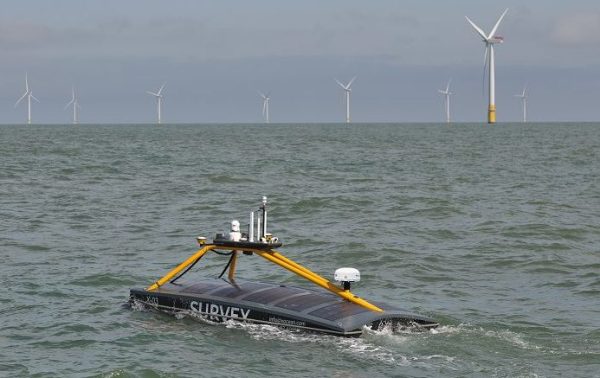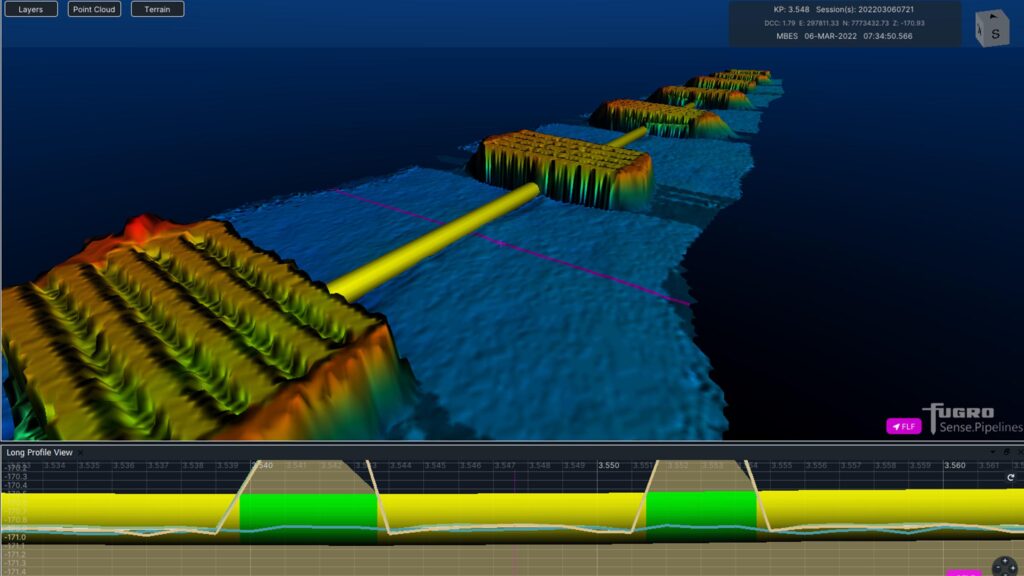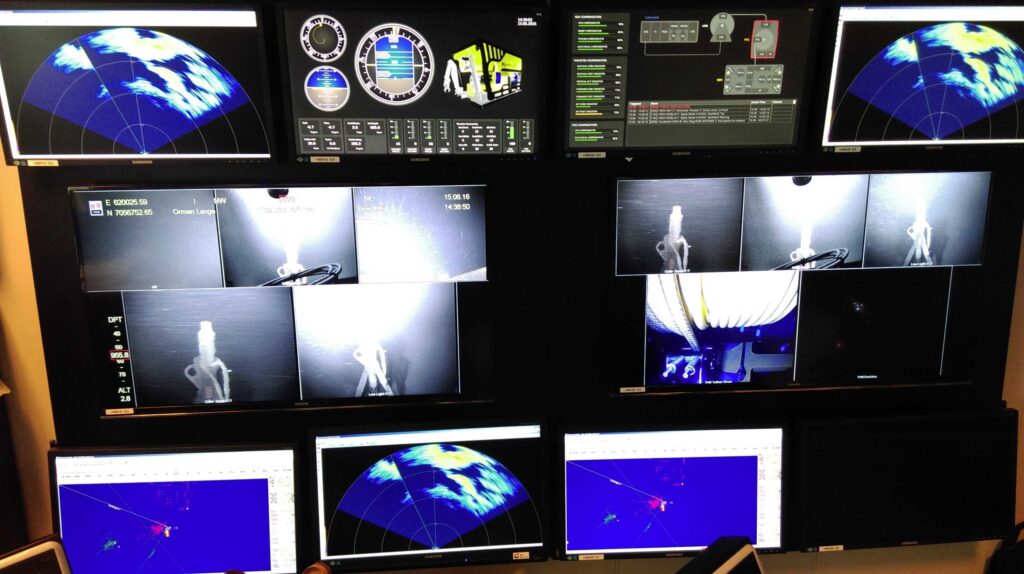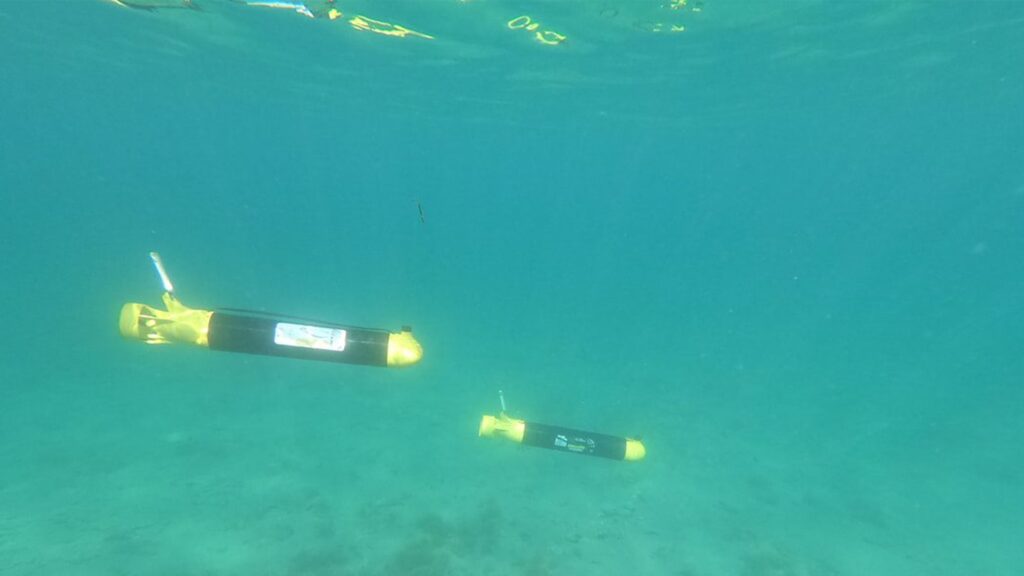Uncrewed surface vehicles are fast becoming a powerful tool in offshore operations across the defence, energy and science sectors.
Marine Robotics Business Development Manager Aidan Thorn explains how using our Ranger 2 family of USBL transceivers with your uncrewed surface vehicles (USVs) enables truly remote operations when tracking, positioning and communicating with unmanned underwater vehicles (UUVs) or gathering data from seabed deployed sensors – and then lets our customers explain how they use theirs.
USVs really add value to operations when used as a force-multiplier for traditional shipborne operations, allowing the ship to continue with more complex work or when operations are entirely remote from ships and infrastructure. Whether it is for mine countermeasures, autonomous data collection or offshore wind farm site characterisation, they’re a valuable, lower cost, lower carbon footprint and lower logistics platform.
One of these operations is the deployment of USVs as a navigational and communications gateway for UUVs. Equipping a USV with a Ranger 2 USBL provides the UUVs, whether working singularly or as a squad, not just with position and tracking updates but also the ability to communicate data back to the USV and on to the operator
We’ve seen our USBL systems deployed on a variety of USVs for customers needing to position and communicate with a UUV, or a number of UUVs, for their applications. Fugro’s Blue Essence USVs have utilised our Mini-Ranger 2 system for tracking an ROV on remote ops when inspecting gas pipelines in Australia.
The University of New Hampshire’s DriX USV also has a Mini-Ranger 2 that has been used for tracking, positioning and communications with two UUVs at a time, so that the underwater vehicles could be sent commands remotely whilst on mission without the need to surface.
And we’re not just limited to one or two UUVs. As part of an Innovate UK funded project, Squads of Autonomous Robots (SOAR) trials have taken place using Sonardyne’s USV, Decibel, fitted with a Ranger 2 USBL acting as a communications gateway for a squad of ecoSUB autonomous underwater vehicles.
But our USBL offering is not just about robot-to-robot operations. An increasing numbers of operators are using the Mini-Ranger 2, coupled with our HPT 3000 USBL transceivers, on their USVs for over the horizon data harvesting. Traditionally getting data back from seabed deployed sensors has involved recovery of the sensors or communicating with them acoustically via a shipborne system.
This is a very costly and carbon intensive method of gathering data. Fitting the HPT 3000 to a USV means that over-the-horizon operations suddenly become more cost effective, more reliable and less risky. This has been demonstrated by our work with XOCEAN at the Norske Shell operated Ormen Lange gas site and, in the Rockall Trough where the SAMS AutoNaut collected data from a seabed AZA.
Most of the examples given above feature our Mini-Ranger 2, as it is the USBL of choice for a variety of USV operations, but the technology is available in sizes to suit almost any requirement. Available in standard, mini or micro variations, the Ranger 2 USBL transceivers can support a range of marine robotic operations. Let’s take a quick look at the products before letting the customers who use them do the talking…
Micro-Ranger 2 USBL
Portable and quick to set up, Micro-Ranger 2 is perfect for your simple USBL tasks such as tracking divers, an ROV or micro AUV. It is a great introduction to USBL operations and its compact size means it can be fitted to a wide range of vessels or used in harbour / pontoon testing. Despite its smaller stature, it can communicate with the same subsea beacons as its larger family members.
Mini-Ranger 2 USBL
Mini-Ranger 2 is our mid-level USBL target tracking system. Its combination of size and performance means that it can be used on USVs to support data harvesting from seabed-deployed instruments or to communicate with underwater assets such as AUVs. Need to track targets further, simultaneously, and with survey-quality precision? Mini-Ranger 2 delivers on both performance and price.
Ranger 2 Standard USBL
Our most capable tracking and DP reference USBL, it is installed on a global fleet of vessels. It can track everything, in any depth, from any vessel. Able to track a towfish, position an ROV, dynamically position your vessel, communicate with an AUV – or do all of this simultaneously – it’s anything but standard.
Further details for the entire Ranger 2 family can be found on our product pages.
The best examples of the Ranger 2 family and HPT 3000’s uses come from our customers. Here’s what a few of them have to say about how our products have helped their autonomous operations.
Oliver Harris, Senior Operations Manager, XOCEAN: “XOCEAN utilise Sonardyne’s advanced seabed monitoring technologies during offshore survey projects. Our team has witnessed firsthand the value that the HPT 3000 brings to our data collection toolkit, enabling us to gather accurate and reliable subsea positioning data efficiently. Additionally, we have integrated Sonardyne’s HPT 3000 onto our USVs for towed Sidescan and Magnetometer surveys, delivering top-notch subsea positioning data to our clients on various offshore wind projects. We continue to grow our data collection offering, having procured several Sonardyne USBL transceivers to deliver this.”

Matt Lussu, Principal Hydrographic Surveyor, Fugro: “We couldn’t be happier with how the Mini-Ranger 2 has performed in ROV tracking from both our Blue Essence USV, Fugro Maali and Fugro Kwilena. We first deployed the USV Fugro Maali with its Mini Ranger USBL system for a client in 2021 on an asset integrity inspection project. Since then, Fugro Australia have taken delivery of our second USV, also equipped with a Mini Ranger 2 system, and have continued to see consistent and reliable performance on commercial programmes for various clients over the past 12 months.”

Roland Arsenault, Autonomous Systems Software Engineer, University of New Hampshire: “Having a communications gateway between the DriX USV and the AUVs adds real value to our operations. The Sonardyne USBL system enabled DriX to direct the Mesobot AUV to sample a layer of interest within the water rather than just have it travel to the area and sample blind. The collaboration with Sonardyne to develop specific ROS drivers for our operations ensuring all robotic platforms can talk to each other through the Mini-Ranger 2 USBL has meant true heterogenous operations.”

Iain Vincent, Director, ecoSUB Robotics Ltd: “When we first developed the ecoSUB AUV the original concept was focused on launch and recovery from a USV. Through the Innovate UK funded Squads of Adaptive Robots project, we’ve integrated Sonardyne’s AvTrak 6 Nano modems into our AUVs and demonstrated the ability to track and communicate with them through Sonardyne’s Ranger 2 USBL onboard a USV, as well as being able to communicate with other AUVs within a squad. Having this ability really strengthens the flexibility of AUV operations, as being able to communicate between different robotic platforms means that each platform can perform its role and hand off to other platforms to perform theirs.”

Mike Poole, Director, AutoNaut: “Using a wave propelled AutoNaut USV, equipped with a Sonardyne Mini-Ranger 2 we achieved the first example of through-water communications of ocean climate research data to an autonomous vehicle, and instant transmission of data to shore. AutoNauts are well suited to long endurance missions in the open ocean, meaning that they can be truly remote vessels. Having the acoustic data gathering capability provided by Sonardyne’s HPT instrument has enabled us to gather zero carbon data for our customers in what is a practical and positive response to climate change.”
If you want to know how our Ranger 2 family could support your underwater robotics, drop us a line. We’ll be happy to help.